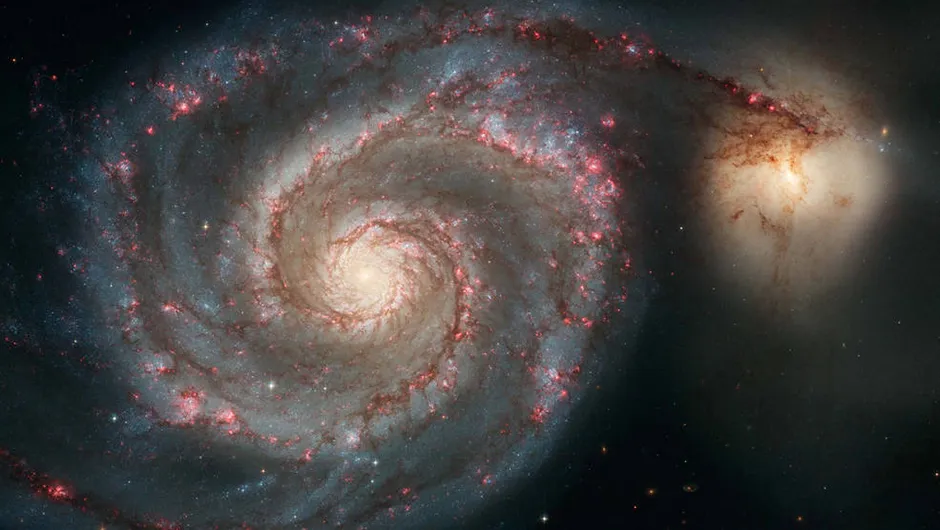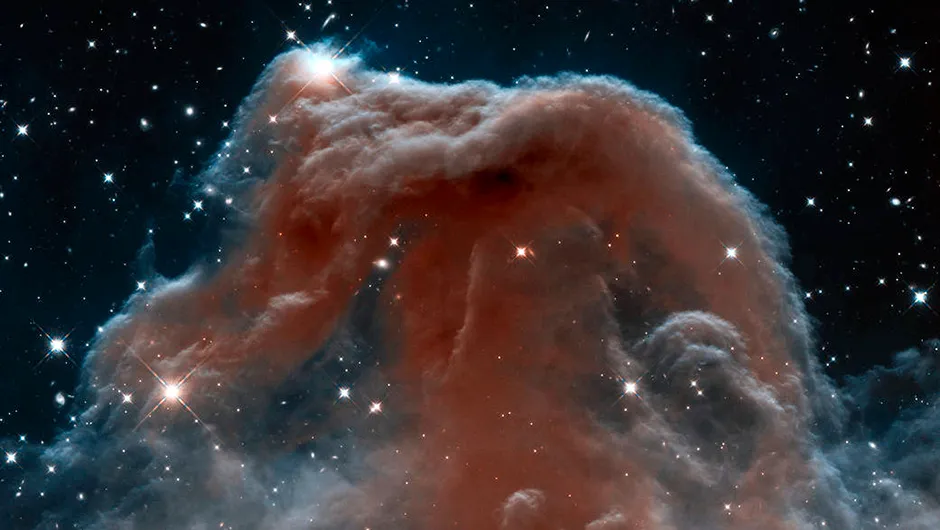Looking up at the sky on a clear, dark night reveals a blaze of light from nearby stars and far-away galaxies.And yet astrophysicists believe this astonishing display represents just 5 per cent of the actual matter present in our universe.
The remaining 95 per cent is dark stuff lurking tantalizingly out of sight – non-luminous or otherwise undetectable material pervading space alongside the bright material that we can see.
Ninety-five per cent of the universe is a big deal – easily enough to decide its ultimate fate.
That all hinges on the total amount of matter out there in space – whether there’s sufficient to ultimately halt cosmic expansion or whether the universe is gravitationally unbound and will continue to expand for ever.
It also turns out to be an important consideration at the other end of the cosmic timeline, strongly influencing the formation of galaxies and clusters of galaxies shortly after the Big Bang.
Nobody’s quite sure what this dark stuff is actually made of – despite many science-budget dollars and cosmologist hours being spent in the quest to find out.
The one thing most researchers are fairly sure about is that it has to be there.
Gravity makes things move – the more gravity there is, the faster they tend to go.
And numerous instances are now known where stars and galaxies seem to move much faster than they should, given the amount of gravity inferred from just the bright material – stars and glowing nebulae – alone.
Bizarrely, scientists came up with a name for the missing material before there was any palpable evidence for it.
In 1906, French mathematician Henri Poincaré used the term dark matter to describe non-luminous material in our Milky Way galaxy.
One of the first to claim to have caught a glimpse of it was the Dutch astronomer Jan Oort, in 1932.
He measured the speeds of stars moving up and down through the disc of the Milky Way.
The gravity of the matter present in the disc makes the stars bob up and down like carousel horses as they circle around the galaxy’s centre.
But Oort saw that the stars weren’t moving as far above or below the plane of the disc as they should be – it was as if the gravitational force holding them back was stronger than could be produced by the amount of material visible in the galactic disc.
The following year, Swiss astronomer Fritz Zwicky provided further evidence.
Zwicky was a brilliant astronomer who coined the term ‘supernova’ for the explosions marking the deaths of massive stars, predicted the existence of neutron stars (the superdense remnant left behind after a supernova) and later pioneered the use of supernovae for gauging distances across the universe.
He also made contributions to the classification and cataloguing of galaxies and correctly predicted that Einstein’s work on the bending of light in general relativity meant that massive objects could curve and focus light like a lens, magnifying any objects behind them – this gravitational lensing effect, as it became known, was subsequently observed in 1979.
Zwicky was also a famously cantankerous personality, frequently falling out with colleagues and acquaintances.
Zwicky was studying a group of more than 1,000 galaxies known as the Coma Cluster, 323 million light-years away from Earth in the constellation of Coma Berenices.
Zwicky measured how fast the galaxies in the cluster were moving.
The simple fact that the galaxies weren’t all flying off into space meant that there must be enough gravity in the cluster to hold them all together as a bound system.
It’s rather like firing a cannon into the air on Earth.
If I see the cannon ball eventually stop and fall back to the ground then I know that the Earth’s gravity, and hence its mass, must be sufficient to halt the ball’s ascent.
If I could fire a number of cannon balls, then in principle I could measure the speed of the slowest ball that’s able to escape the Earth’s pull and from this use Newton’s law of gravity to deduce the planet’s mass.
But when Zwicky did this for the galaxies in the Coma Cluster, he found that the mass of the cluster, calculated from its gravity, didn’t square at all with the figure he got by simply adding up the estimated masses of all its galaxies.
Estimating the mass of a distant galaxy isn’t straightforward.
If the galaxy is nearby, you can measure the motions of its stars and, again like the cannon ball analogy, get a handle on how much gravitating material must be present in order to prevent the stars whizzing off into space.
However, at hundreds of millions of light-years distant, the individual stars making up the galaxies in the Coma Cluster could not be resolved.
Instead, Zwicky used what astronomers refer to as a mass-to-light ratio.
By studying a number of typical nearby galaxies – measuring their brightnesses and estimating their masses from the speeds of their constituent stars – an average ratio of the amount of mass present per unit of brightness can be deduced.
Zwicky could then apply these ratios to the observed brightness of each of the galaxies in the Coma Cluster to derive an estimate of its total mass.
When he did this and found that the value he got for the cluster’s mass was hundreds of times smaller than that inferred from the galaxy speeds, Zwicky pronounced that the only resolution was for there to be a large quantity of material in the cluster that couldn’t be seen.
Zwicky’s numbers were in fact a little wide of the mark, mainly because 1930s estimates of the Hubble constant, which governs the expansion rate of the universe, were way too big.
This led Zwicky to overestimate the distance to the Coma Cluster (remember, the distance is given by the measured recession speed multiplied by the Hubble constant).
And this in turn threw out his estimate of the quantity of dark matter required to hold it together, though his broad conclusions – that most of the cluster’s mass is invisible – were later borne out.
During the 1970s, American astronomer Vera Rubin, working with colleague Kent Ford, both at the Carnegie Institution of Washington, uncovered evidence for dark matter existing on smaller scales.
They were studying spiral galaxies – that is, swirling collections of stars, much like our own Milky Way – and in particular their rotation curves, graphs showing how the speed at which stars are circling around the galaxy varies with the distance from its centre.

Newton’s law of gravity dictated that outside the galaxies’ bright central nucleus the rotation speeds should decrease with the distance from the centre.
Close to the centre, Rubin’s observations agreed with theoretical predictions.
But in the outer region of a galaxy – known as the halo – theory and observation went their separate ways.
Rubin and Ford found the rotation speed in the haloes to be roughly constant, not decreasing at all.
(In fact, there are very few stars in the halo of a galaxy and so Rubin measured the rotation rate here by tracking the motion of glowing clouds of hydrogen gas.)
The only way this could happen is if the halo was chockfull of hidden dark matter, making up at least 50 per cent of each galaxy’s total mass.
In the late 1990s, international collaborations of astronomers using images and data gathered by the Earth-orbiting Hubble Space Telescope (HST) began to study the gravitational lensing by clusters of far-away quasars.
These are very distant galaxies, also known as quasi-stellar objects – so named because they’re so far away that they appear as pinpricks of light when observed through a telescope, resembling a star rather than the usual fuzzy form of a galaxy.
They are ferociously bright, each powered by a giant black hole at its core weighing anything up to several billion times the mass of the sun.
The black hole is devouring the stars and gas in the host galaxy, which spews out radiation as it gets compressed and heated by the intense gravity.
At the time of writing, in spring 2018, the most distant quasar known lies an astonishing 13 billion light-years away, and the light that we see from it was released when the universe was just a few hundred million years old.
Although point-like when seen in a normal telescope, viewing a quasar through the gigantic natural telescope formed by a gravitational lens deforms the image into one or more bananashaped arcs.
Einstein showed that an exact alignment between the observer, the quasar and the cluster, and with all of the cluster’s mass concentrated in a point at the centre, would stretch the image into a perfect ring.
In practice, these simplifications are rarely valid. But for astronomers studying dark matter that’s a good thing.
By modelling the gravitational influence of the lensing cluster on a computer, they’re able to invert the observed structure of the arcs in the image, to reconstruct how the mass of the cluster is distributed within it.
Doing this reveals sharp peaks of mass corresponding to the individual galaxies, superimposed on to a smooth background of matter between them.
This smooth background is invisible dark matter, which is estimated to account for upwards of 85 per cent of the cluster’s mass.
So what exactly might this strange stuff be made of? The initial temptation may be to think that dark matter is just ordinary matter that’s not giving off any light.
After all, you and I are both made of ordinary matter and we’re not luminous.
Asteroids plying the depths of the solar system are non-luminous, unless we happen to catch a glint of sunlight reflected from them.
And we know for a fact that there are dark dust clouds out in space – think, for instance, of the iconic image of the Horsehead Nebula.

This is a cloud of hydrogen gas in the constellation of Orion that’s being illuminated and caused to glow bright pink by a nearby bright star.
Part of the glowing gas cloud is obscured by a blotch of intervening dust to form a striking silhouette in the shape of a horse’s head.
The trouble is that so much dark matter is required that if it was made from ordinary matter it would reveal itself to us.
If the dark matter was dust we’d see it obscuring the light from many more stars and bright nebulae – in exactly the same way that we can see the Horsehead.
Even if it was in the form of small dark bodies, we would still see them.
For example, not so long ago it was thought that some of the dark matter in galaxies could exist in the form of what are called massive compact astrophysical halo objects, or MACHOs, swirling around in the galaxies’ outer halos.
MACHOs are a broad class of objects.
They include brown dwarfs – essentially failed stars, each a sphere of hydrogen gas (exactly like an embryonic star) but which has failed to grow massive enough to spark up nuclear fusion in its core.
Also included are stellar remnants – that is, superdense objects (including black holes and cooled neutron stars and white dwarfs) left behind after a star has ended its life.
